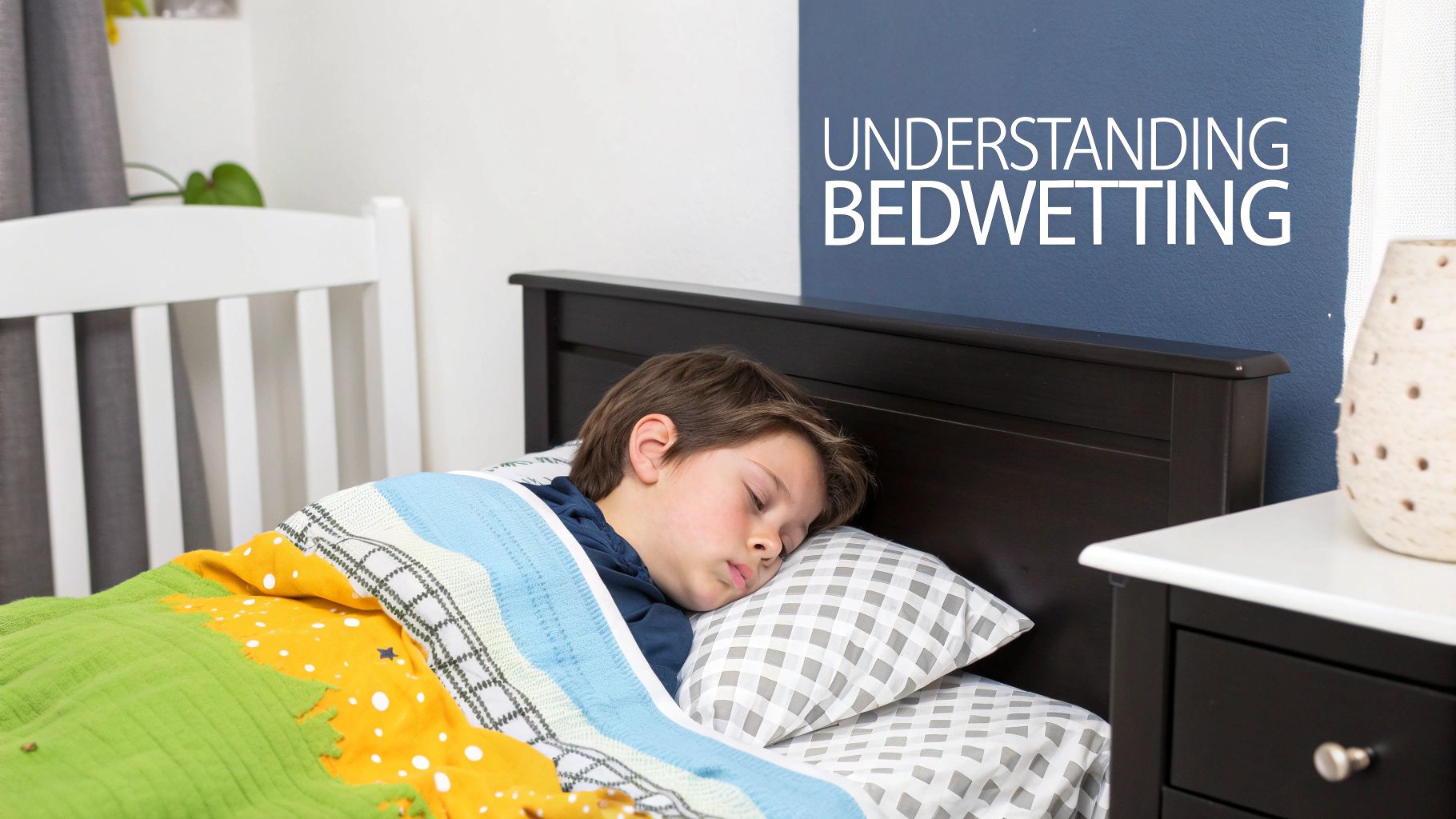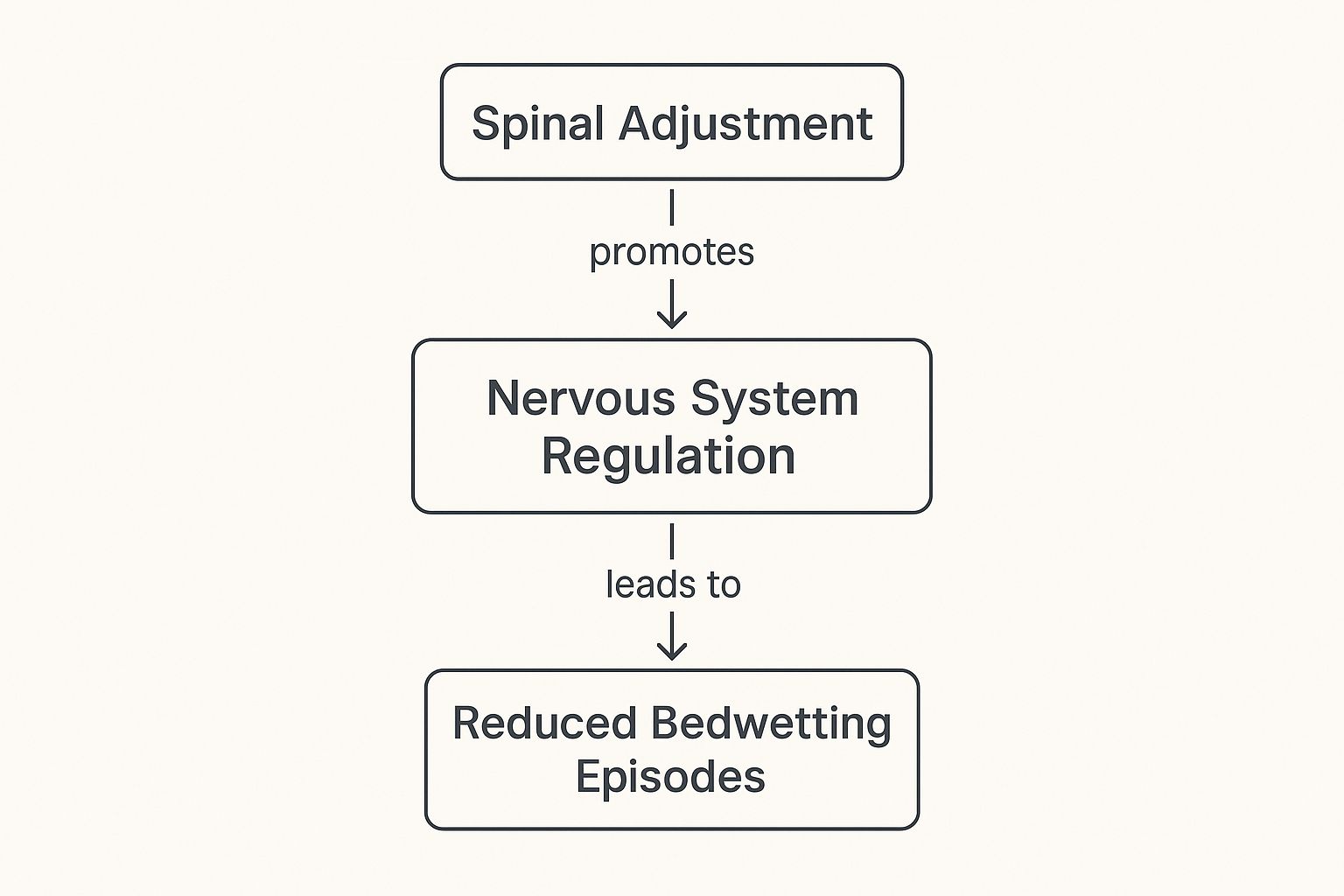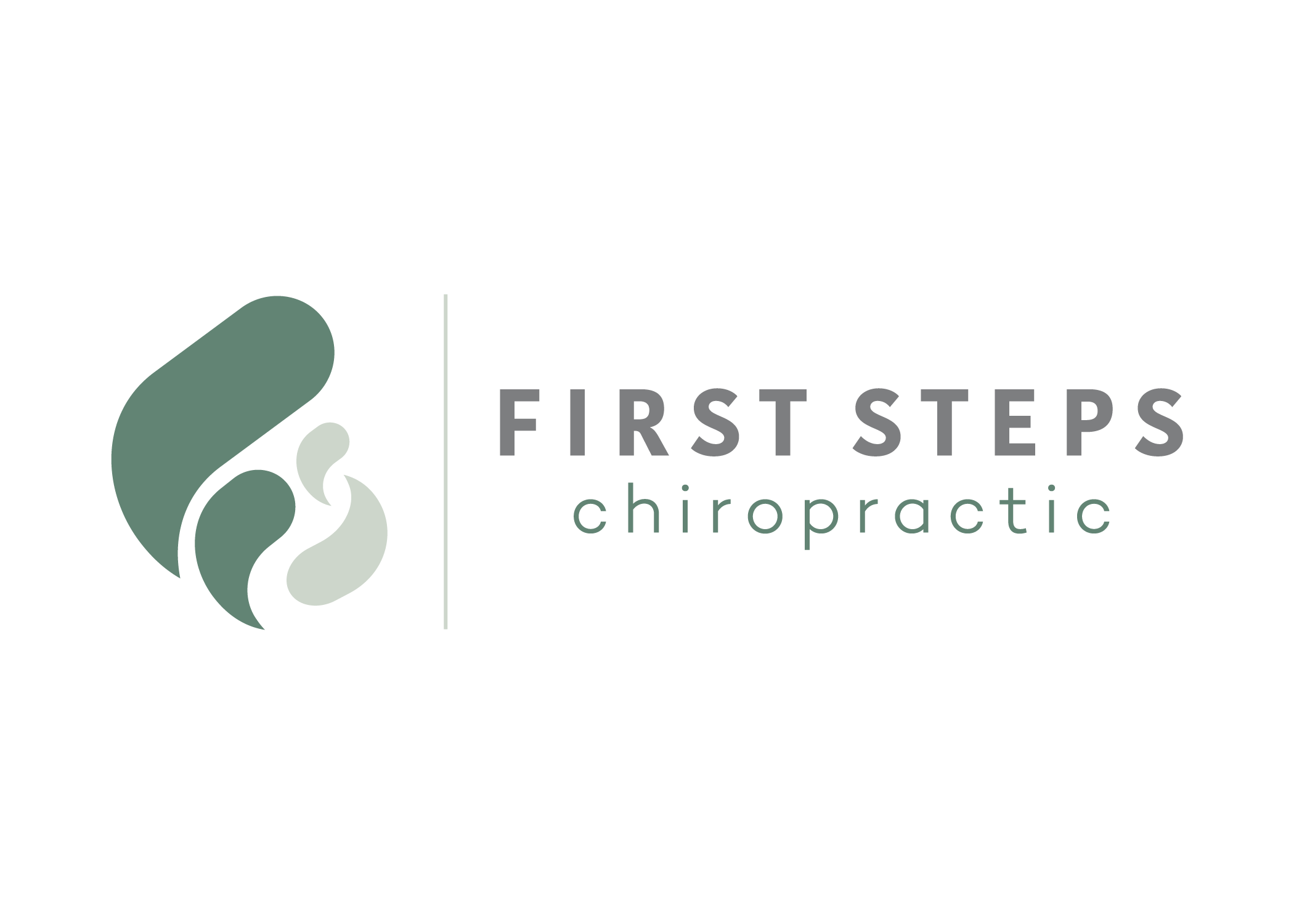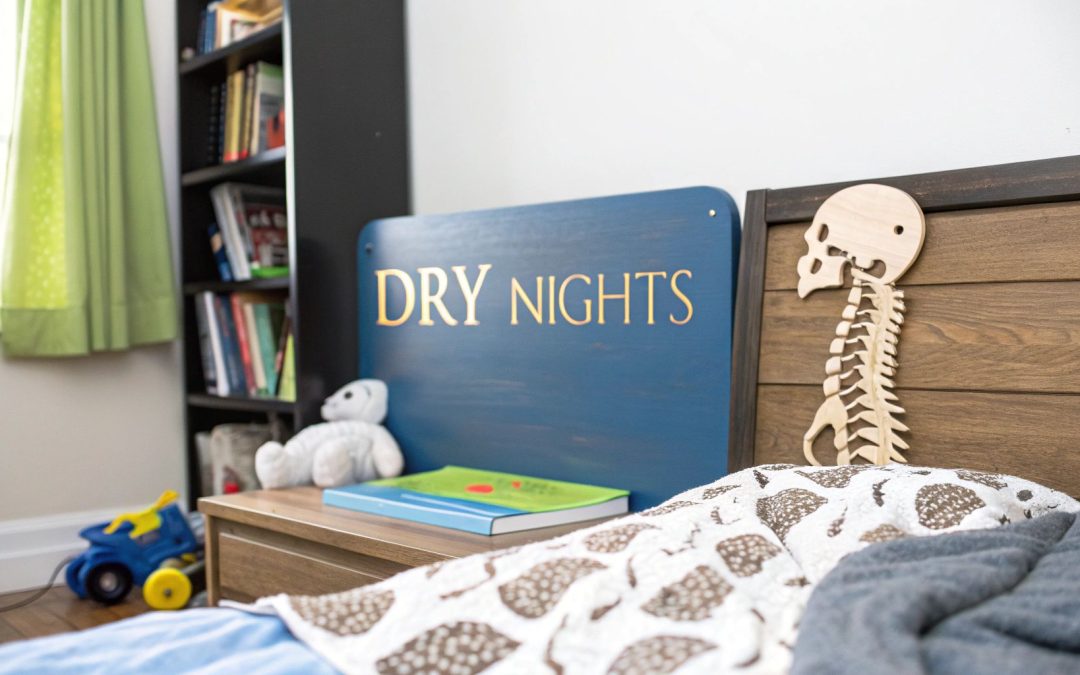For so many families, bedwetting is a sensitive, frustrating, and often misunderstood issue. The link between chiropractic and bedwetting isn't obvious at first, but it comes down to one critical system: the nervous system. The entire focus of chiropractic care is to improve that vital communication pathway between the brain and the bladder. With gentle adjustments, we can often help resolve the communication breakdowns that lead to wet nights, offering a natural path toward a solution.
The Overlooked Link Between Spine Health and Bladder Control

When a child struggles with bedwetting, known clinically as nocturnal enuresis, it's easy to write it off as a behavioral problem or just a phase they'll eventually outgrow. But for many kids, the real issue is physiological—a disconnect in the body’s internal messaging system. This is where chiropractic care offers a completely different, and often very effective, perspective.
The nervous system is the body's master control network. It sends signals from the brain to every single organ, including the bladder. These messages travel down the spinal cord, which is housed and protected by the spine. If small misalignments, which we call subluxations, happen in the spine (especially in the lower back and sacral areas), they can create interference.
Think of it like static on a phone line. If the message from the bladder ("I'm full!") or from the brain ("Wake up and go!") gets distorted by this static, the body simply can't respond correctly during sleep.
Understanding the Scope of Bedwetting
If you’re dealing with this, you are far from alone. Bedwetting is incredibly common, affecting up to 25% of children, and it tends to be more frequent in boys than girls. The numbers show that at age 5, about 15% of kids still wet the bed. By age 10, that number drops to around 5%. You can learn more about the growing body of research on chiropractic and bedwetting that supports this approach.
Chiropractic care for bedwetting is all about clearing up that "static." By using gentle, specific adjustments, a pediatric chiropractor helps restore proper alignment and movement in the spine. This, in turn, can improve nerve function, allowing the brain and bladder to finally communicate clearly. We aren't treating the symptom (the wet bed); we're addressing the underlying nerve interference so the body can get back to regulating itself the way it was designed to.
How Nerve Signals Impact Bladder Function
Think of your child’s nervous system as a complex communication highway and their spine as its protective guardrail. For the bladder to work correctly through the night, a couple of critical messages have to travel this highway without any static or traffic jams.
First, a signal needs to travel from a full bladder all the way up to the brain, clearly saying, "Hey, we're reaching capacity!" Then, a return signal must travel from the brain back down to the bladder with the command, "Hold on, we're sleeping. It's not time yet." When this communication loop is working perfectly, a child either stays dry all night or wakes up to use the bathroom.
The Role of Spinal Alignment
The specific nerves that control the bladder exit from the lower part of the spine—the lumbar and sacral regions. Minor spinal misalignments, which we call subluxations, can happen in this area from totally normal childhood events like falls, tumbles while playing, or even the birth process itself.
These misalignments can create tension and put pressure on the surrounding nerves. This essentially creates "static" on that communication highway, disrupting those vital signals between the brain and the bladder. When that happens, a sleeping child’s brain might not clearly get the "I'm full" message, or the bladder might not receive the "hold on" command in time. This is the core idea behind using chiropractic for bedwetting. If you'd like to dive deeper into this connection, check out our guide on chiropractic and the nervous system.
The simple concept map below shows how chiropractic adjustments can influence this process, potentially leading to fewer bedwetting episodes.

This graphic illustrates the pathway from gentle spinal adjustments to better nerve regulation, which is exactly what we're aiming for to improve bladder control.
Real-World Impact on Children
When we can restore clear nerve communication through gentle adjustments, the body gets much better at regulating its own functions. This isn't about treating a disease; it's about removing interference so the body can do the job it's designed to do.
The main goal of chiropractic care here is to clear the neurological pathways. This allows the brain and bladder to communicate effectively, even when a child is fast asleep, enhancing the body's natural ability to self-regulate.
This approach has led to some incredible outcomes in practice. For instance, one case study looked at a 10-year-old girl who had struggled with bedwetting her entire life. She saw improvements after just the first few visits and experienced a complete resolution after her 14th visit.
By focusing on the root cause—nerve interference—chiropractic care offers a supportive, non-invasive way to help a child's body function at its best. This helps build a strong foundation for achieving dry nights and, just as importantly, boosting a child’s confidence.
What a Pediatric Chiropractic Visit Involves

We get it—the thought of taking your child to a chiropractor can feel a little daunting. The good news is that a pediatric visit is a world away from adult care. It's an incredibly gentle, reassuring process designed specifically for a child’s developing body, where comfort and safety are the top priorities.
The entire experience is built around making sure your child feels secure. The very first visit kicks off with a conversation, not an adjustment. We'll take all the time needed to listen to your family’s story, understand your child's history, and get a clear picture of the specific bedwetting challenges you’re facing.
The Gentle Assessment Process
After our chat, we move on to a careful and completely non-invasive examination. This isn’t about looking for pain; it's about finding subtle signs of nerve interference that could be contributing to the issue.
This assessment usually includes a few key steps:
- Postural Analysis: We simply observe how your child sits and stands to spot any subtle imbalances in their structure.
- Palpation: Using a very light touch along the spine, we feel for areas of restricted movement, tension, or misalignment.
- Nerve Scans: We use advanced, totally safe, radiation-free technology to measure the activity in the nervous system. These scans give us a precise map, pinpointing the exact areas of interference along the spine that might be impacting bladder control.
This detailed assessment gives us a roadmap for care. You can learn more about this amazing technology in our guide to the chiropractic nerve scan and see how it helps us create a plan that’s perfect for your child.
What the Adjustment Feels Like
When you hear "adjustment," forget any ideas of forceful "cracking" or "popping." That's not what we do here. Pediatric chiropractic adjustments are incredibly gentle and precise.
The amount of pressure used is often compared to what you would use to test the ripeness of a tomato—it’s that light. Many children don't even realize the adjustment is happening, and some even find it relaxing.
Using specific, low-force techniques, the chiropractor gently encourages the vertebrae back into their proper alignment. The goal is simple: to remove the interference in the nervous system. This allows that vital communication highway between the brain and the bladder to function clearly, without any static on the line.
Ultimately, the whole visit is designed to be a positive and empowering experience. By replacing uncertainty with confidence, we can show you just how safe and comfortable these visits are. The focus is always on working with your child's body to help it heal and regulate itself naturally, paving the way for drier nights and happier kids.
Exploring the Research Behind This Approach

As a parent, whenever you consider a new approach for your child's health, the first question is always, "What does the science say?" It's a great question to ask. The link between chiropractic and bedwetting is backed by a growing collection of case studies and clinical reports, but it’s important to look at this evidence with a clear and realistic lens.
You'll find many studies in peer-reviewed literature that document positive changes for kids undergoing chiropractic care for nocturnal enuresis. While these are often small-scale studies or individual case reports, they consistently show a pattern of improvement. In these documented cases, children frequently see a major drop in how often they have wet nights, and some find complete resolution.
For instance, one report followed a nine-year-old boy who had never experienced a single dry night. After his chiropractor identified and corrected a misalignment in his lower spine and sacroiliac (SI) joint, his bedwetting episodes plummeted. Within just seven weeks of care, he was down to only occasional accidents—a truly life-changing shift for him and his family.
Understanding the Outcomes
Stories just like that one are common in chiropractic offices, and more of them are being documented all the time. The success is often tied to adjustments in the lower lumbar spine and sacrum. This makes perfect sense, as these are the exact areas where the nerves controlling the bladder exit the spinal column.
The thinking here is that by restoring proper alignment, chiropractic adjustments can reduce nerve interference. This allows the brain and bladder to communicate clearly, without any static on the line.
The goal isn't to make definitive claims but to present the evidence as it stands. The positive results seen in numerous case studies suggest a strong connection between spinal health and bladder control, making it a worthwhile avenue for parents to explore.
Instead of just managing symptoms, this approach focuses on getting to a potential root cause.
The Current State of the Science
While these individual success stories are compelling, we also need to be upfront about the current limitations of the research. To date, there haven't been many large-scale, double-blind clinical trials—the "gold standard" of medical research—looking specifically at chiropractic care for bedwetting. This means that while anecdotal evidence and case studies are very promising, the broader scientific community agrees that more robust research is needed.
Some studies have shown mixed results, which likely points to the fact that bedwetting can have multiple causes. For one child, a spinal issue might be the main driver, while another's situation could be completely different. This is exactly why a thorough, individual evaluation is so critical.
Still, the existing body of evidence provides a strong foundation and a logical reason why chiropractic and bedwetting are so often discussed together. It gives you an informed perspective, showing that for many children, this gentle and non-invasive approach has made a profound difference on their journey to achieving dry nights.
Building a Supportive At-Home Routine
While chiropractic care is a powerful tool for getting that brain-body communication back online, its effects are truly magnified when you combine it with a supportive and consistent routine at home.
This is where you, as a parent, become an absolutely crucial part of the team on the journey to dry nights. Creating a holistic strategy helps reduce stress on the nervous system, supports healthy bladder function, and reinforces all the positive changes happening in your child’s body.
Simple, consistent habits can make a world of difference. By focusing on a few key areas—fluids, diet, and bedtime rituals—you create an environment that truly sets your child up for success.
Creating a Bladder-Friendly Evening
The goal here isn't to restrict water but to time it strategically. You absolutely want to encourage your child to drink plenty of fluids all throughout the day. This keeps them well-hydrated, which in turn keeps the bladder healthy and accustomed to stretching properly.
But as evening rolls around, start tapering off fluid intake about two hours before bedtime. This gives the body plenty of time to process liquids and reduces the amount of urine being produced overnight. It's also wise to avoid sugary drinks, dairy, and caffeine in the evening, as they can irritate the bladder or act as diuretics.
A key part of the routine should be a "double void" before lights out. Have your child use the toilet at the beginning of the bedtime routine (say, before brushing their teeth) and then one final time right before getting into bed. This simple step ensures the bladder is as empty as possible before they fall asleep.
Mindful Nutrition and Bladder Irritants
What your child eats can play a role, too. It turns out certain foods and additives are known bladder irritants for some children, which can increase urinary urgency or frequency. Every child is different, of course, but some common culprits to be mindful of include:
- Artificial Colors: Dyes like Red 40, often found in sports drinks, candies, and some cereals, can be problematic.
- Certain Preservatives: Some preservatives used in processed foods may irritate a sensitive bladder.
- High-Citrus Foods: Oranges, grapefruits, and tomatoes can be acidic and may contribute to bladder irritation for some kids.
You don't need to eliminate everything at once. The idea is to simply become aware of these potential triggers so you can start to notice if there's a pattern between your child's diet and their bedwetting frequency.
To help you put these evening strategies into practice, here is a simple checklist you can adapt for your family.
Actionable Evening Checklist for Drier Nights
| Time/Action | Goal | Notes for Parents |
|---|---|---|
| 2 Hours Before Bed | Taper Fluids | Switch from big drinks to small sips. Avoid sugary drinks, dairy, and caffeine. |
| 1 Hour Before Bed | Start Wind-Down | Begin a calming, screen-free routine like reading, quiet music, or gentle stretches. |
| 30 Mins Before Bed | First Void | Have your child use the bathroom at the start of the final bedtime prep (e.g., before PJs). |
| Right Before Bed | Final "Double" Void | One last trip to the bathroom to make sure the bladder is completely empty before sleep. |
| Overnight | Clear Path & Night Light | Make the path to the bathroom safe and easy to navigate in the dark, just in case. |
Remember, consistency is far more important than perfection. Stick with it, and these small steps can add up to big progress over time.
Fostering a Positive and Stress-Free Environment
Above all else, your emotional support is the single most important element of any at-home routine. Bedwetting is never the child’s fault, and creating a shame-free, supportive atmosphere is absolutely essential. We know that stress and anxiety can significantly impact nervous system function and bladder control.
Implement a calm, predictable bedtime routine to help your child’s nervous system wind down for the night. This could be as simple as reading a book together, listening to quiet music, or doing a few gentle stretches.
Celebrate every small victory, like a dry morning, with genuine positive reinforcement. And on wet nights, remain patient, loving, and understanding. Your unconditional support reduces the emotional burden on your child, which in itself is a powerful step toward resolving the issue for good.
How to Find the Right Pediatric Chiropractor
Choosing the right practitioner for your child is easily the most important step in exploring the connection between chiropractic and bedwetting. Not all chiropractors are the same, and finding someone with specific training and deep experience in caring for children is absolutely essential for your family’s peace of mind and success.
Your first step should always be to look for chiropractors who have gone the extra mile with advanced training in pediatric care. This specialized education ensures they truly understand the delicate nuances of a child's developing nervous system and only use techniques that are exceptionally gentle and safe.
Key Credentials to Look For
When you start vetting potential chiropractors, don’t be shy about asking about their specific qualifications. You’ll want to look for certifications that show a real commitment to pediatric chiropractic.
Keep an eye out for credentials like these:
- CACCP: Certified by the Academy Council of Chiropractic Pediatrics
- DACCP: Diplomate with the Academy Council of Chiropractic Pediatrics
These certifications aren't just letters after a name—they represent hundreds of hours of additional education focused entirely on caring for children and pregnant women. A chiropractor with this level of training will be an expert in the gentle, specific techniques required for pediatric adjustments.
Finding a practitioner who truly listens, communicates clearly, and makes your child feel comfortable is just as important as their qualifications. This partnership should be built on trust and open dialogue, where you feel heard and empowered as a parent.
Questions to Ask a Potential Chiropractor
Once you have a shortlist, the next step is to schedule a consultation call or a visit to their office. This is your chance to get a feel for their approach and make sure they’re the right fit for your family. Our guide on finding a great "pediatric chiropractor near me" offers even more tips to help you in your search.
Here are a few essential questions to get you started:
- What specific training do you have in pediatric chiropractic?
- How much experience do you have helping children with bedwetting?
- What gentle, low-force techniques do you use for kids?
- How do you make sure my child feels safe and comfortable during their visits?
- Are you open to working with our pediatrician or other healthcare providers?
Finding a provider who can confidently and openly answer these questions will set you on the right path to finding the perfect partner for your family's wellness journey.
Common Questions About Chiropractic for Bedwetting
Exploring a new path for your child’s health always brings up questions, and that's a good thing. When parents first learn about the connection between chiropractic and bedwetting, they often have the same key concerns. Let's walk through them one by one.
Is Chiropractic Care Safe for My Child?
Absolutely. This is the first question on every parent's mind, and the answer is a resounding yes. Pediatric adjustments are incredibly gentle and specifically designed for a child's growing body.
We’re not talking about the kind of adjustments you might imagine for an adult. The pressure used is often no more than what you’d use to check a ripe tomato. A qualified pediatric chiropractor has extensive, specialized training to make sure every single visit is safe, comfortable, and positive for your little one.
How Long Until We See Improvements?
Every child is unique, and their body will respond to care at its own pace. Some parents tell us they see exciting changes—like fewer wet nights or a child sleeping more soundly—within just a few weeks of starting. For others, the improvements are more gradual and unfold over a couple of months.
The most important factor here is consistency. Sticking with the recommended care plan gives your child's nervous system the time it needs to adapt, heal, and rebuild those clear communication lines between the brain and bladder.
Will Insurance Cover This Type of Care?
This is a practical question that really depends on your specific insurance plan, as coverage for chiropractic care can vary quite a bit. The most direct way to find out is to call your provider and ask specifically about coverage for a dependent.
To help them give you the clearest answer, it’s useful to mention terms like "nocturnal enuresis" (the clinical term for bedwetting) or "segmental and somatic dysfunction." Using this language helps the insurance representative locate the exact benefits within your plan. A quick phone call can clear up any confusion right from the start.

